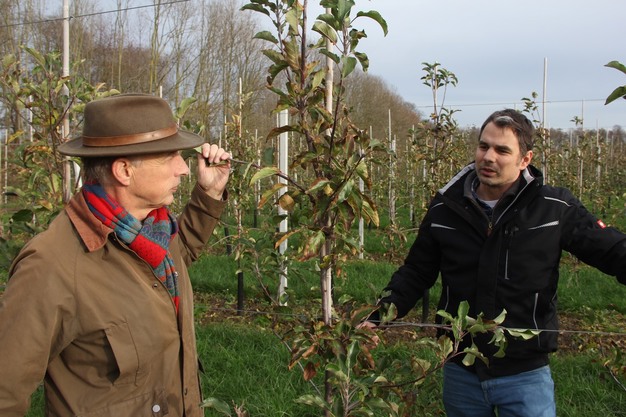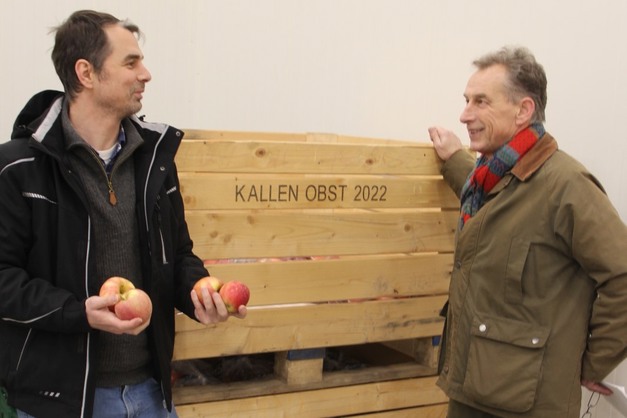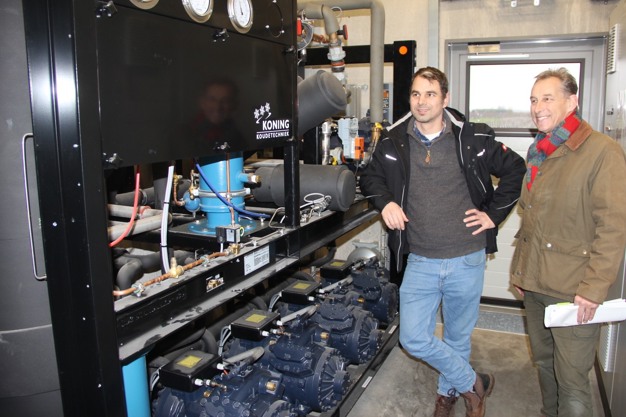Last year, the Lower Rhine family business Kallen Obst was able to take over a well-established farm shop in the neighborhood. "The previous owners gave due to old age – a very welcome opportunity for us to expand our direct business with the customers. Another focus of our direct marketing is our sales outlet at Schloss Dyck. Generally speaking, we sell about 70 percent of the fruit in our own outlets and through regional market suppliers and farm shops. The increasing demand is the result of a long development and a consistent quality production," father Bruno and his son Thomas Kallen said.
The fruit-growing business, based in Korsenbroich, covers a total of 110 hectares, of which 95 hectares are fruit (55 hectares of plums and 7 hectares of Hauszwetschen or mirabelles, as well as 12 hectares of shrub berries, mainly of the Rovada variety). 40 hectares of the orchard is located directly on the farm. "One special feature is that we have planted a block of 25 hectares of apple trees. We grow the classic direct marketer assortment. In particular, the Wellant variety is becoming one of the most in-demand varieties."

Father Bruno and son Thomas Kallen run the fruit farm in Korsenbroich together.
Processing and rapid cooling
The Rovada variety (95 percent) is mainly grown in the currant sector, thanks to its good fruit characteristics and stability during and especially after storage, according to the management.
"We are always looking for alternatives, but so far, other varieties have not convinced us!" The red currants are almost entirely harvested in crates and then immediately sent to the blast chiller, followed by storage. They are then sorted and later packed into sales packages according to customer requirements. The entire harvest is stored in order to come into its own when market conditions return to 'normal' and prices are attractive."
In midsummer, i.e. before the top fruit harvest, mainly red currants and various plum varieties are harvested. Kallen: "In peak years, several hundred tons are picked and at midsummer temperatures. Our experience is that the fastest cooling guarantees the best shelf life. Because we harvest for flavor, rapid cooling slows further ripening. This is the only way we can offer our customers plums that are both aromatic and stable." Harvesting currants also presents its challenges. "In 2023, we had to harvest Rovada under very rainy conditions, which made the fruit very susceptible to fungi. The longest-stored berries were stored at CO₂ levels of up to 22 percent, fruit temperatures at +0.8°C and O₂ at 1.3 percent. Thanks to the targeted cooling process with simultaneous maximum dehumidification, we were able to sell almost all lots at optimal quality – well into the fall."

Innovations in fruit storage
A few years ago, the next generation, with son Thomas, fully entered the business with the goal of setting the course for the future. The first goal was to push ahead with the construction of a new building. "The main purpose of this new capacity was to combine sorting and storage and to have (CA) goods available immediately, thus making optimal use of sales opportunities. We have developed short distances from the plant to the cooling system in order to professionalize the harvest and delivery to the packing shed as quickly as possible, saving time and maintaining quality. The most difficult decision was whether to use CO₂ or the glycol system we favor for storage. The fact that brine cooling requires a high pump output and thus high energy consumption was an argument against it."
Based on the facts available and experience with energy consumption in other top fruit projects, the decision was finally made in favor of the CO₂ direct expansion variant. Bruno Kallen: "It was clear to us that the installation was somewhat more expensive than the less expensive variant with Freon. However, this storage technology is more predictable in terms of energy costs and, above all, more future-proof. Besides, due to environmental restrictions, only systems with a cooling capacity of up to 40 kW are still allowed. We would have needed at least five separate systems for the cooling capacity we require. We could have bought the glycol system for the same price as CO₂, but the power consumption would have been significantly higher over the course of a year."
Today, the fruit-growing business has 17 cold stores, 13 of which are CA cells, with a total cold storage capacity of 3,000 large boxes. The total cooling capacity of all the rooms is just under 300 kW. The simultaneity makes it possible to work with 60 percent of the calculated compressor capacity. "Extrapolated, we reach this maximum cooling capacity with 50 m³ of displacement, delivered by five CO₂ compressors. Of several interesting offers, we liked the one from Koning the best. At first we were skeptical, but the price remained the same from the offer to the final invoice, there were no surprises! And then the installation process; everything prefabricated in Bakel (NL) - everything fitted perfectly here in the extension, so that we were able to store our fruit as planned shortly before the start of the harvest. That's what you call precision work!" according to the two-man management team.

Investment bears fruit
"We can now hold back the fruit for as long as necessary to optimally serve the market. After the first year, we can already say that it was a good investment. The produce is of high quality, is stored well and the customers keep coming back – not the goods!" they conclude.
Photos & text: Herbert Knuppen
For more information:
Bruno and Thomas Kallen
Kallen Obst
Schanzerhof
41352 Korschenbroich
Phone: +49 (0) 2182.41 38
E-Mail: [email protected]
www.kallen-obst.de
